Thanks to the handy LDS Scripture Citation Index (LDSSCI), it’s easy to get data to answer this question. I looked up each of the current members of the Quorum of 15 to see how often he cited the Old Testament, New Testament, Book of Mormon, Doctrine and Covenants, and Pearl of Great Price in his Conference talks. For example, for President Monson, the counts are 332, 818, 184, 255, and 32, respectively. Here are counts for all Quorum members:
| Counts | ||||||
|---|---|---|---|---|---|---|
| Member | OT | NT | BoM | D&C | PGP | Total |
| Monson | 332 | 818 | 184 | 255 | 32 | 1621 |
| Packer | 125 | 312 | 559 | 470 | 96 | 1562 |
| Perry | 95 | 116 | 141 | 106 | 74 | 532 |
| Nelson | 399 | 695 | 910 | 945 | 209 | 3158 |
| Oaks | 149 | 538 | 504 | 386 | 60 | 1637 |
| Ballard | 26 | 139 | 133 | 111 | 32 | 441 |
| Scott | 25 | 57 | 203 | 144 | 34 | 463 |
| Hales | 77 | 336 | 291 | 187 | 78 | 969 |
| Holland | 70 | 243 | 140 | 74 | 24 | 551 |
| Eyring | 27 | 97 | 162 | 135 | 16 | 437 |
| Uchtdorf | 56 | 166 | 126 | 121 | 28 | 497 |
| Bednar | 19 | 60 | 148 | 87 | 15 | 329 |
| Cook | 27 | 57 | 73 | 82 | 9 | 248 |
| Christofferson | 11 | 129 | 139 | 118 | 26 | 423 |
| Andersen | 17 | 98 | 102 | 59 | 11 | 287 |
Next, to adjust for the fact that Quorum members differ in the total number of scripture citations they put in their talks, I converted the counts of citations to percentages of all citations by the member. Using President Monson as an example again, this means dividing each of his counts by book (332, 818, 184, 255, and 32) by his total (1621) to get his percentages. Here are percentages for all Quorum members:
| Percentages | ||||||
|---|---|---|---|---|---|---|
| Member | OT | NT | BoM | D&C | PGP | |
| Monson | 20% | 50% | 11% | 16% | 2% | |
| Packer | 8% | 20% | 36% | 30% | 6% | |
| Perry | 18% | 22% | 27% | 20% | 14% | |
| Nelson | 13% | 22% | 29% | 30% | 7% | |
| Oaks | 9% | 33% | 31% | 24% | 4% | |
| Ballard | 6% | 32% | 30% | 25% | 7% | |
| Scott | 5% | 12% | 44% | 31% | 7% | |
| Hales | 8% | 35% | 30% | 19% | 8% | |
| Holland | 13% | 44% | 25% | 13% | 4% | |
| Eyring | 6% | 22% | 37% | 31% | 4% | |
| Uchtdorf | 11% | 33% | 25% | 24% | 6% | |
| Bednar | 6% | 18% | 45% | 26% | 5% | |
| Cook | 11% | 23% | 29% | 33% | 4% | |
| Christofferson | 3% | 30% | 33% | 28% | 6% | |
| Andersen | 6% | 34% | 36% | 21% | 4% | |
(Note that the percentages do not add to 100 for some members because of rounding.)
Finally, I did one more adjustment to account for the norms of how often the different books of scripture are cited in Conference by all speakers during the years each Quorum member served. What I mean here is that at different points in time, different books of scripture were cited more or less by all speakers in Conference. Because members have been in the Quorum for different amounts of time, some of the differences between them can be accounted for by the different norms in Conference at the times they were giving talks.
The biggest shift in the time current Quorum members have served has been an increase in citations of the Book of Mormon. Here’s a graph showing the percentage of all citations of scriptures in Conference that came from each of the five books of scripture since 1942 (as far back as the LDSSCI has Conference talk data).
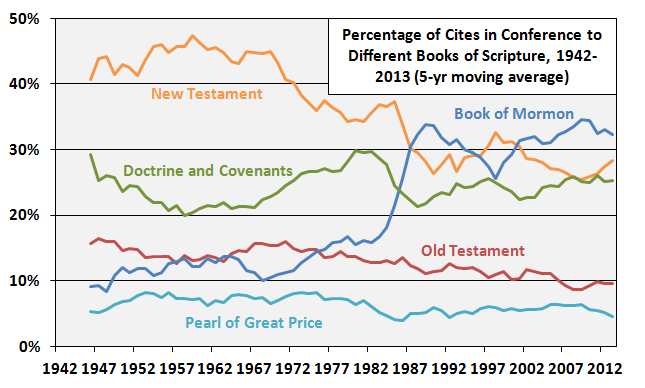 The Book of Mormon was on a gradually increasing trajectory until the mid-1980s, but then got a big bump, and has largely stayed the most-cited book of scripture ever since. And of course, the percentages for other books of scripture declined at the same time, because the total of the citation percentages always has to add to 100. The important point is just to notice that there are changes over time in which books of scripture get cited the most. That’s what I’m adjusting for. For example, a member who has been in the Quorum since the 1960s (as President Monson has) would be expected to have used relatively more New Testament citations than a member who has only been in the Quorum for a decade (as President Uchtdorf has), simply because the first member gave more talks in a time when citing the New Testament more was the norm.
The Book of Mormon was on a gradually increasing trajectory until the mid-1980s, but then got a big bump, and has largely stayed the most-cited book of scripture ever since. And of course, the percentages for other books of scripture declined at the same time, because the total of the citation percentages always has to add to 100. The important point is just to notice that there are changes over time in which books of scripture get cited the most. That’s what I’m adjusting for. For example, a member who has been in the Quorum since the 1960s (as President Monson has) would be expected to have used relatively more New Testament citations than a member who has only been in the Quorum for a decade (as President Uchtdorf has), simply because the first member gave more talks in a time when citing the New Testament more was the norm.
To adjust for this change over time, for each Quorum member, I looked up the years in which he has served in the Quorum and calculated the percentage of scriptural citations to each book of scripture for all Conference speakers, averaging across the years he has served (through 2013, the latest year for which data is available in LDSSCI). Here are average percentages for each of the five books of scripture for all Quorum members:
| Conference average percentages (all speakers) | ||||||
|---|---|---|---|---|---|---|
| Member | Enter yr | OT | NT | BoM | D&C | PGP |
| Monson | 1963 | 12% | 33% | 24% | 25% | 6% |
| Packer | 1970 | 12% | 31% | 26% | 25% | 6% |
| Perry | 1974 | 11% | 30% | 27% | 25% | 6% |
| Nelson | 1984 | 11% | 29% | 31% | 24% | 5% |
| Oaks | 1984 | 11% | 29% | 31% | 24% | 5% |
| Ballard | 1985 | 11% | 28% | 31% | 24% | 5% |
| Scott | 1988 | 11% | 29% | 31% | 25% | 5% |
| Hales | 1994 | 10% | 29% | 31% | 25% | 6% |
| Holland | 1994 | 10% | 29% | 31% | 25% | 6% |
| Eyring | 1995 | 10% | 28% | 31% | 25% | 6% |
| Uchtdorf | 2004 | 9% | 27% | 33% | 26% | 5% |
| Bednar | 2004 | 9% | 27% | 33% | 26% | 5% |
| Cook | 2007 | 9% | 28% | 32% | 26% | 5% |
| Christofferson | 2008 | 9% | 28% | 32% | 26% | 5% |
| Andersen | 2009 | 10% | 28% | 32% | 25% | 5% |
(Note that the percentages do not add to 100 for some members because of rounding.)
Comparing President Monson and President Uchtdorf, for example, because President Monson was in the Quorum both before the Book of Mormon bump of the 1980s and after it, then his comparison percentages are more Bible-heavy than are those of President Uchtdorf, who has only been in the Quorum after the Book of Mormon bump. I calculated a set of comparison percentages like this for each Quorum member. Then I subtracted the comparison percentages from the Quorum member’s percentages to find out which books of scripture he cited more than the typical Conference talk of his time, and which he cited less. Here’s the calculation for President Monson:
| Quantity | OT | NT | BoM | D&C | PGP |
|---|---|---|---|---|---|
| Pres Monson % | 20% | 50% | 11% | 16% | 2% |
| Conference % | 12% | 33% | 24% | 25% | 6% |
| Difference (pct point) | +8 | +18 | -13 | -9 | -4 |
(Note that in the New Testament column, the difference does not equal the difference between the first two rows because of rounding.)
One housekeeping issue: In the “difference” row, I dropped the percent signs because differences between percentages are expressed in percentage points and not percentages. (For a brief explanation of the distinction, see here.) The graphs below also show percentage points because I am taking differences between percentages.
Getting back to the content of the table, it looks like even compared to the Conference norms in which he has given talks, President Monson cites both the Old and New Testaments more than usual, and the Book of Mormon, D&C, and Pearl of Great Price less.
I did the corresponding adjustments for all other members of the Quorum. The results are below. I’ve organized them by book of scripture to make it easier to see which members are outliers for each. Here is the graph for the Old Testament.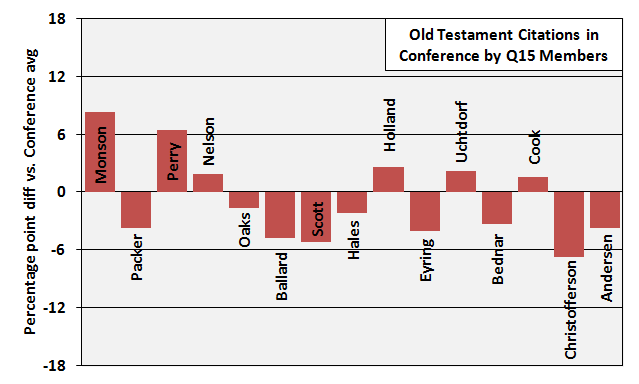
President Monson shows the most preference for the Old Testament among Quorum members. Elder Christofferson shows the least preference.
Here is the graph for the New Testament:
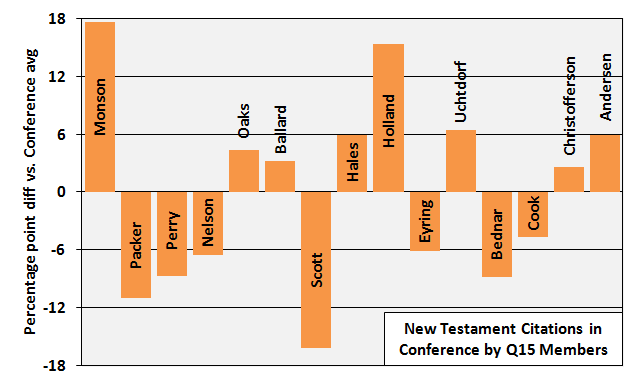 There is more variability here than for the Old Testament. President Monson and Elder Holland cite the New Testament a lot more than the norms of their time; Elder Scott cites it much less than the norm.
There is more variability here than for the Old Testament. President Monson and Elder Holland cite the New Testament a lot more than the norms of their time; Elder Scott cites it much less than the norm.
Here is the graph for the Book of Mormon:
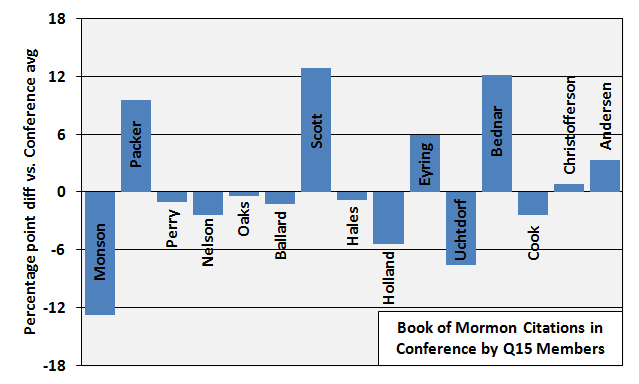 President Monson is again an outlier, citing from the Book of Mormon much less frequently than other Conference speakers, even with the adjustment for the fact that he gave many talks prior to the Book of Mormon bump of the 1980s. President Packer, Elder Scott, and Elder Bednar show up as citing the Book of Mormon more than the norm.
President Monson is again an outlier, citing from the Book of Mormon much less frequently than other Conference speakers, even with the adjustment for the fact that he gave many talks prior to the Book of Mormon bump of the 1980s. President Packer, Elder Scott, and Elder Bednar show up as citing the Book of Mormon more than the norm.
Here is the graph for the Doctrine and Covenants:
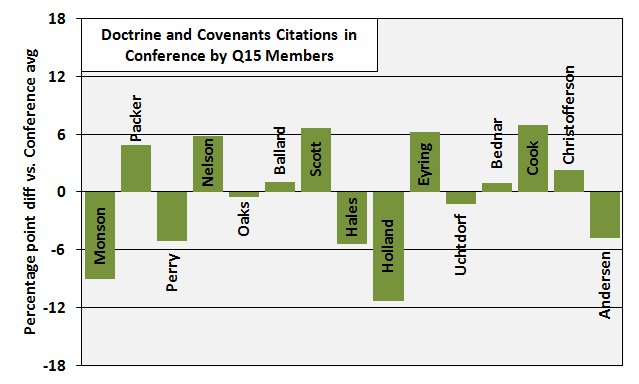 President Monson and Elder Holland cite the D&C comparatively little. Nobody stands out on the high side to the degree that these two do on the low side.
President Monson and Elder Holland cite the D&C comparatively little. Nobody stands out on the high side to the degree that these two do on the low side.
Here is the graph for the Pearl of Great Price:
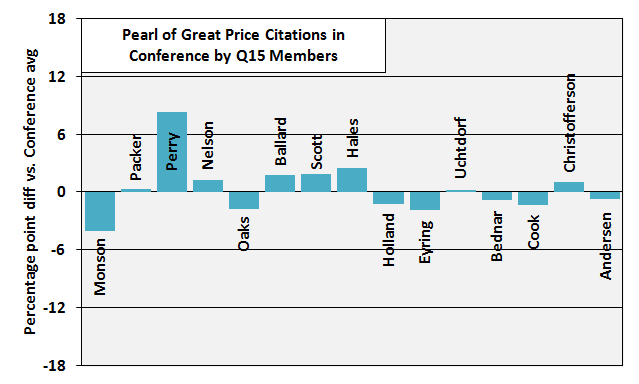 Elder Perry is the big outlier here. I checked what he was citing in the Pearl of Great Price, and over half of his references were to the Articles of Faith.
Elder Perry is the big outlier here. I checked what he was citing in the Pearl of Great Price, and over half of his references were to the Articles of Faith.
Note: In case you want to see them, I have added graphs that show results organized by Quorum member. I put them in a separate post.
One obvious question to ask after looking across all the books of scripture is which Quorum members were most often furthest from the norms for each book, and which were closest. For each member, I calculated his total absolute percentage point difference by adding up the absolute values of his difference scores for each of the five books. You can think of this as just adding up the heights of his five bars from the five graphs above, regardless of whether the bars were pointing up or down. Here is the result:
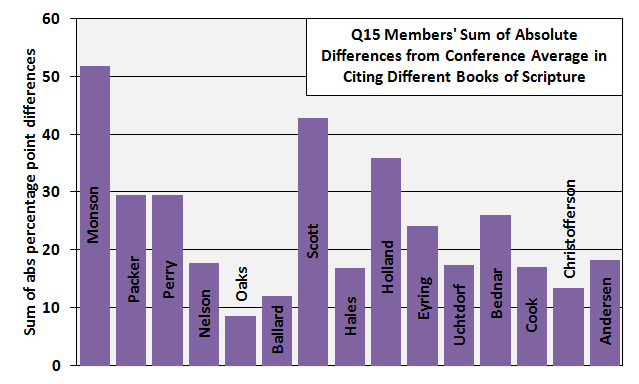 President Monson really is an outlier. Looking back at the individual graphs, he cites the Bible more than the norm, and latter-day scriptures less. At the other end, Elder Oaks matches the Conference norms very closely.
President Monson really is an outlier. Looking back at the individual graphs, he cites the Bible more than the norm, and latter-day scriptures less. At the other end, Elder Oaks matches the Conference norms very closely.
Before I wrap up the post, I had a couple of tangential thoughts that I thought would be interesting enough to include, but not enough to go into a post of their own.
Tangent 1
What do you think was the cause of the dramatic increase in citations of the Book of Mormon shown in the first graph above? President Benson’s famous talk on the Book of Mormon, right? That’s what I thought it was, anyway. But here’s what’s strange: President Benson did not give that talk until after that increase had occurred. You can’t see this level of detail in the graph because I used five-year moving averages to smooth out the data, but here are the yearly percentages of Conference citations of scriptures that were citations of the Book of Mormon for the decade of the 1980s:
1980: 13%
1981: 17%
1982: 15%
1983: 21%
1984: 24%
1985: 29%
1986: 38% < — President Benson gives his talk in October
1987: 39%
1988: 30%
1989: 32%
There are some jigs and jags, but it looks like references to the Book of Mormon had already roughly doubled before President Benson even gave his talk. And he gave his talk in October, so the first Conference it should have been able to have an effect would be in 1987, when the percentage of citations going to the Book of Mormon inched up only a single percentage point, only to fall back and stabilize at a lower level.
It’s possible that President Benson was still the driver of this trend. Perhaps he was talking about the importance of the Book of Mormon in venues where his fellow GAs heard him before he gave his big Conference talk, so they realized it was going to be a bigger point of emphasis and started talking about it more as well. But the trend reaches back to President Kimball’s term, and I wonder if this doesn’t suggest that rather than driving the trend, President Benson was, when he put new emphasis on the Book of Mormon, simply reflecting a trend that was already ongoing.
Tangent 2
One other thought that occurred to me when looking at the first graph in this post is that I could look at how often the Bible is cited in Conference versus how often latter-day scriptures are cited. This would be interesting because it might be an indicator of how much Church leaders were thinking about emphasizing our similarities with other religions (so they cite the Bible more) versus our differences (so they cite latter-day scriptures more). Here’s a graph that takes the data from the first graph in this post and collapses it into the Bible versus latter-day scriptures (and I’m just showing the percentages for the Bible, since the percentages for latter-day scriptures will just be a mirror image).
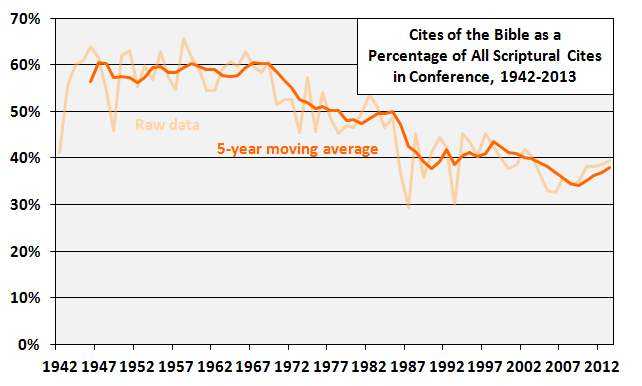 It’s interesting to see that there has been a declining trend in citing the Bible in Conference that started in the early 1970s and continues maybe even through today, although with some periods of flattening in between. I think this trend is consistent with what Armand Mauss described in The Angel and the Beehive as a period of retrenchment for the Church between the 1950s and 1990s. Retrenchment would be expected to correspond to more citations of latter-day scriptures and fewer citations of the Bible.
It’s interesting to see that there has been a declining trend in citing the Bible in Conference that started in the early 1970s and continues maybe even through today, although with some periods of flattening in between. I think this trend is consistent with what Armand Mauss described in The Angel and the Beehive as a period of retrenchment for the Church between the 1950s and 1990s. Retrenchment would be expected to correspond to more citations of latter-day scriptures and fewer citations of the Bible.
This is very interesting, thanks.
I would like to know the raw numbers of total scripture citations for each. Does Elder Holland cite the BoM more times in total (regardless of other numbers) than Elder Scott for instance? Are there large differences in the number of scriptures cited per talk between the Q15? Are there any trends over time in this respect? Also, how often in conference reports are scriptures referred to, but not cited properly?
Ooh, yeah. Can you share the raw data?
Also, it’d be fascinating to see the data for just presidents of the Church since 1942 (so Heber J. Grant up to Thomas S. Monson)
I love these analyses that you put together, Ziff.
I think another variable worth accounting for here would be the frequency that each person cites scriptures in their talks. Some will they talks in references while others will put in a few scant references. I wonder what correlations there are between frequency and distribution.
Great stats again!
I wonder if Pres. Romney’s emphasis, plus the new scriptures and the 150th anniversary of the Book of Mormon publication all near the same time were the reasons for the rise in citations in the early 80s.
.
I just realized I was primed to become a FiveThirtyEight regular by reading Ziff.
You could consider normalizing the different books so they all have equal weight. This would better account for the fact that there are many more scriptures to choose from in the Old Testament than in the other books and give a better sense of what is most popular. It’s like saying the GDP vs. The GDP per capita… The per capita portion accounts for population differences.
Love this analysis. As an engineer, I love to look at things analytically/graphically to see trends.
I have some questions that I would like to see answered regarding the type of references that were being cited from the various standard works. For example, are we seeing a greater increase in talks on obedience and following the brethren compared with charitable works…..you know….the things Christ taught. As you can see, my bias is showing. I feel that there is a greater emphasis today on following the brethren than actually following Christ’s teachings of love and compassion towards our fellow (wo)men.
Until you look at those data you can’t really make any conclusions.
I love this (and all of your data posts)! Thanks for taking the time to do the work. I’d just like to echo the questions voiced in the above comments.
Thanks everyone for your kind words and suggestions. Th, in particular, that may be the nicest comment I’ve ever gotten!
For those of you who wanted to see the raw data (counts), I’ve updated the post to include them. As you can see, there are huge differences in how many total scripture citations different Quorum members make. Elders Nelson and Oaks were called the same year, but Nelson has almost twice as many citations as Oaks does. And Ballard, called just the next year, has fewer than a third as many as Oaks.
For the rest of your suggestions, sorry, but they involve more work than I can get into now. I’ll file them away to maybe look at another time.
Paul, you might enjoy this post I wrote a couple of years ago on pretty much the topic you’re asking about:
https://zelophehadsdaughters.com/2011/05/24/obedience-is-the-first-law-of-earth/
el oso, thanks for your suggestion of an alternative cause of the Book of Mormon bump. I’m a little too young to remember that, but it seems plausible!
I made one other addition, which is a series of graphs showing results organized by Quorum member rather than by book of scripture. To avoid cluttering this post up further, I put them in a separate post:
https://zelophehadsdaughters.com/2014/07/10/which-gas-prefer-which-books-of-scripture-supplemental-material/
I feel an odd, internal discord as I realize that posts like these keep me engaged with my religion in a positive way.
I realize this would come with a ton more work, but could you do this with the women leaders? I wonder if the trends would follow the same pattern.
Oooh, great idea, BethSmash! I’ll definitely give that one a look.
It’s actually not much work to get data for more people. It’s the analyses that would require me to break down their references by talk, or actually look through the references that would be difficult. But LDSSCI makes getting total counts for a person really easy.